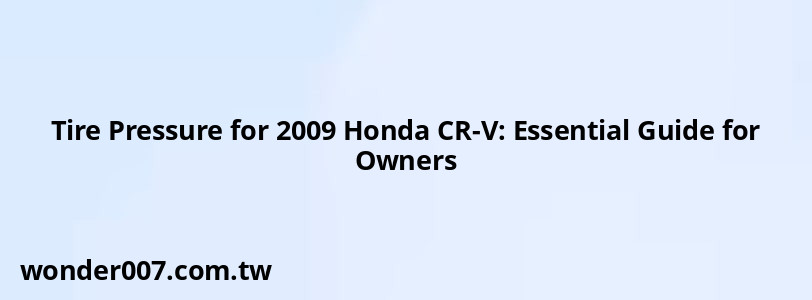Tire Pressure for 2009 Honda CR-V: Essential Guide for Owners

The recommended tire pressure for the 2009 Honda CR-V is crucial for ensuring optimal performance, safety, and fuel efficiency. Vehicle owners typically seek this information to maintain their tires properly and avoid potential issues related to improper inflation.
Recommended Tire Pressure
For the 2009 Honda CR-V, the recommended tire pressures are as follows:
- Front Tires: 30 psi (210 kPa)
- Rear Tires: 30 psi (210 kPa)
These values are applicable for standard tire sizes, specifically 225/65R17. It is important to note that these recommendations are based on cold tire conditions, meaning the tires should be checked when the vehicle has been stationary and not driven for at least a few hours.
Importance of Maintaining Proper Tire Pressure
Maintaining the correct tire pressure is essential for several reasons:
- Safety: Underinflated tires can lead to blowouts and reduced vehicle handling, increasing the risk of accidents.
- Fuel Efficiency: Properly inflated tires improve fuel economy. Underinflation can decrease gas mileage significantly.
- Tire Longevity: Keeping tires at the recommended pressure helps prevent uneven wear and extends their lifespan.
- Comfort: Correct tire pressure contributes to a smoother ride by enhancing vehicle stability and comfort.
How to Check Tire Pressure
To ensure your tires are properly inflated:
1. Use a Tire Pressure Gauge: Purchase an accurate gauge or visit a service station that offers one.
2. Check When Cold: Measure tire pressure when the tires are cold for an accurate reading. If you have driven recently, wait at least three hours before checking.
3. Consult the Placard: Locate the tire pressure placard on the driver’s side door jamb of your CR-V for specific recommendations.
4. Adjust as Necessary: Inflate or deflate your tires to match the recommended pressures.
FAQs About Tire Pressure for 2009 Honda CR-V
FAQs About Tire Pressure
- What should I do if my tire pressure light is on?
If your tire pressure warning light is illuminated, check all tire pressures immediately and inflate them to the recommended levels. - Can I use a different tire size?
Using a different tire size may require adjustments in recommended tire pressures. Always consult your owner's manual or a professional if you change tire sizes. - How often should I check my tire pressure?
It is advisable to check your tire pressure at least once a month and before long trips.
By following these guidelines, you can ensure that your 2009 Honda CR-V remains safe and efficient on the road. Regular maintenance of your tire pressure is a simple yet effective way to enhance your driving experience.
Related Posts
-
Alternator for a 2004 Chevy Impala: Your Complete Guide
28-01-2025 • 149 views -
2012 Hyundai Elantra Limited: Essential Oil Type Guide
28-01-2025 • 182 views -
5.7 Hemi Oil Temperature Sensor Location Guide
28-01-2025 • 183 views -
Cabin Air Filter for 2012 Chrysler 200: Maintenance and Replacement Guide
29-01-2025 • 149 views -
2011 Chevy Traverse Catalytic Converter Diagram and Guide
27-01-2025 • 195 views
Latest Posts
-
How To Turn Off Paddle Shifters Mercedes
01-02-2025 • 377 views -
2015 Chevy Traverse AC Recharge Port Location
01-02-2025 • 409 views -
Power Steering Fluid Leak On Passenger Side
01-02-2025 • 457 views -
Are O2 Sensors Covered Under Warranty
01-02-2025 • 376 views -
Rear Brake Caliper Piston Won't Compress
01-02-2025 • 356 views
Popular Posts
-
EPC Warning Light: What It Means for Your Vehicle
27-01-2025 • 630 views -
V12 Engine Costs: What You Need to Know
26-01-2025 • 679 views -
Hino Warning Lights: Understanding Dashboard Alerts
26-01-2025 • 765 views -
Power Steering and ABS Light On: Causes and Solutions
27-01-2025 • 643 views -
EPC Light: Understanding Causes and Solutions
26-01-2025 • 1053 views
